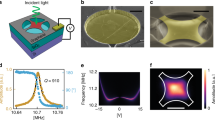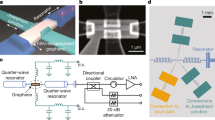Abstract
High sensitivity, fast response time and strong light absorption are the most important metrics for infrared sensing and imaging. The trade-off between these characteristics remains the primary challenge in bolometry. Graphene with its unique combination of a record small electronic heat capacity and a weak electron–phonon coupling has emerged as a sensitive bolometric medium that allows for high intrinsic bandwidths1–3. Moreover, the material’s light absorption can be enhanced to near unity by integration into photonic structures. Here, we introduce an integrated hot-electron bolometer based on Johnson noise readout of electrons in ultra-clean hexagonal-boron-nitride-encapsulated graphene, which is critically coupled to incident radiation through a photonic nanocavity with Q = 900. The device operates at telecom wavelengths and shows an enhanced bolometric response at charge neutrality. At 5 K, we obtain a noise equivalent power of about 10 pW Hz–1/2, a record fast thermal relaxation time, <35 ps, and an improved light absorption. However the device can operate even above 300 K with reduced sensitivity. We work out the performance mechanisms and limits of the graphene bolometer and give important insights towards the potential development of practical applications.
This is a preview of subscription content, access via your institution
Access options
Access Nature and 54 other Nature Portfolio journals
Get Nature+, our best-value online-access subscription
$29.99 / 30 days
cancel any time
Subscribe to this journal
Receive 12 print issues and online access
$259.00 per year
only $21.58 per issue
Buy this article
- Purchase on Springer Link
- Instant access to full article PDF
Prices may be subject to local taxes which are calculated during checkout




Similar content being viewed by others
References
Fong, K. C. & Schwab, K. C. Ultrasensitive and wide-bandwidth thermal measurements of graphene at low temperatures. Phys. Rev. X 2, 031006 (2012).
McKitterick, C. B., Prober, D. E. & Karasik, B. S. Performance of graphene thermal photon detectors. J. Appl. Phys. 113, 044512 (2013).
Yan, J. et al. Dual-gated bilayer graphene hot-electron bolometer. Nat. Nanotech. 7, 472–478 (2012).
Balandin, A. A. Thermal properties of graphene and nanostructured carbon materials. Nat. Mater. 10, 569–581 (2011).
Fong, K. C. et al. Measurement of the electronic thermal conductance channels and heat capacity of graphene at lowtemperature. Phys. Rev. X 3, 041008 (2013).
Crossno, J. et al. Observation of the Dirac fluid and the breakdown of the Wiedemann–Franz law in graphene. Science 351, 1058–1061 (2016).
Mak, K. F. et al. Measurement of the optical conductivity of graphene. Phys. Rev. Lett. 101, 196405 (2008).
Walsh, E. D. et al. Graphene-based Josephson-junction single-photon detector. Phys. Rev. Appl. 8, 024022 (2017).
Du, X., Prober, D. E., Vora, H. & Mckitterick, C. B. Graphene-based bolometers. Graphene 2D Mater. 1, 1–22 (2014).
Vora, H., Kumaravadivel, P., Nielsen, B. & Du, X. Bolometric response in graphene based superconducting tunnel junctions. Appl. Phys. Lett. 100, 153507 (2012).
Cai, X. et al. Sensitive room-temperature terahertz detection via the photothermoelectric effect in graphene. Nat. Nanotech. 9, 814–819 (2014).
Han, Q. et al. Highly sensitive hot electron bolometer based on disordered graphene. Sci. Rep. 3, 3533 (2013).
El Fatimy, A. et al. Epitaxial graphene quantum dots for high-performance terahertz bolometers. Nat. Nanotech. 11, 335–338 (2016).
Nair, R. R. et al. Fine structure constant defines visual transparency of graphene. Science 320, 1308 (2008).
Li, Z. Q. et al. Dirac charge dynamics in graphene by infrared spectroscopy. Nat. Phys. 4, 532–535 (2008).
McKitterick, C. B., Prober, D. E. & Rooks, M. J. Electron-phonon cooling in large monolayer graphene devices. Phys. Rev. B Condens. Matter 93, 075410 (2016).
Dean, C. R. et al. Boron nitride substrates for high-quality graphene electronics. Nat. Nanotech. 5, 722–726 (2010).
Gan, X. et al. Strong enhancement of light–matter interaction in graphene coupled to a photonic crystal nanocavity. Nano Lett. 12, 5626–5631 (2012).
Bao, Q. & Loh, K. P. Graphene photonics, plasmonics, and broadband optoelectronic devices. ACS Nano 6, 3677–3694 (2012).
Gabor, N. M. et al. Hot carrier–assisted intrinsic photoresponse in graphene. Science 334, 648–652 (2011).
Gao, Y. et al. High-speed electro-optic modulator integrated with graphene-boron nitride heterostructure and photonic crystal nanocavity. Nano Lett. 15, 2001–2005 (2015).
Shiue, R.-J. et al. Enhanced photodetection in graphene-integrated photonic crystal cavity. Appl. Phys. Lett. 103, 241109 (2013).
Takano, H., Song, B. S., Asano, T. & Noda, S. Highly efficient multi-channel drop filter in a two-dimensional hetero photonic crystal. Opt. Express 14, 3491–3496 (2006).
Zheng, J., Barton, R. A. & Englund, D. Broadband coherent absorption in chirped-planar-dielectric cavities for 2D-material-based photovoltaics and photodetectors. ACS Photonics 1, 768–774 (2014).
Piper, J. R. & Fan, S. Total absorption in a graphene monolayer in the optical regime by critical coupling with a photonic crystal guided resonance. ACS Photonics 1, 347–353 (2014).
Marini, A., Cox, J. D. & de Abajo, F. J. G. Theory of graphene saturable absorption. Phys. Rev. B 95, 125408 (2017).
Tielrooij, K. J. et al. Generation of photovoltage in graphene on a femtosecond timescale through efficient carrier heating. Nat. Nanotech. 10, 437–443 (2015).
Graham, M. W., Shi, S.-F., Ralph, D. C., Park, J. & McEuen, P. L. Photocurrent measurements of supercollision cooling in graphene. Nat. Phys. 9, 103–108 (2012).
Shiue, R.-J. et al. High-responsivity graphene–boron nitride photodetector and autocorrelator in a silicon photonic integrated circuit. Nano Lett. 15, 7288–7293 (2015).
Tielrooij, K. J. et al. Out-of-plane heat transfer in van der Waals stacks: electron–hyperbolic phonon coupling. Nat. Nanotech. 13, 41–46 (2018).
Sun, D. et al. Ultrafast hot-carrier-dominated photocurrent in graphene. Nat. Nanotech. 7, 114–118 (2012).
Tielrooij, K.-J. et al. Out-of-plane heat transfer in van der Waals stacks through electron–hyperbolic phonon coupling. Nat. Nanotech. 13, 41–46 (2018).
Dicke, R. H. The measurement of thermal radiation at microwave frequencies. Rev. Sci. Instrum. 17, 268–275 (1946).
Acknowledgements
We thank L. Levitov, D. Prober, P. Kim and F. Koppens for fruitful discussions. D.K.E. acknowledges support from the Ministry of Economy and Competitiveness of Spain through the Severo Ochoa programme for Centres of Excellence in R&D (SEV-2015-0522), Fundació Privada Cellex, Fundació Privada Mir-Puig, the Generalitat de Catalunya through the CERCA program and the La Caixa Foundation. D.E. acknowledges support from the Office of Naval Research under grant no. N00014-14-1-0349. Y.G., C.T. and J.H. acknowledge support from the US Office of Naval Research, grant N00014-13-1-0662. K.C.F. acknowledges support from Raytheon BBN Technologies. B.S. was supported as part of the MIT Center for Excitonics, an Energy Frontier Research Center funded by the US Department of Energy, Office of Science, Basic Energy Sciences under award no. DE-SC0001088. J.Z. carried out research in part at the Center for Functional Nanomaterials, Brookhaven National Laboratory, which is supported by the US Department of Energy, Office of Basic Energy Sciences, under contract no. DE-SC0012704. This work is supported in part by the Semiconductor Research Corporation’s NRI Center for Institute for Nanoelectronics Discovery and Exploration (INDEX).
Author information
Authors and Affiliations
Contributions
D.K.E., K.C.F. and D.E. conceived and designed the experiments. D.K.E. and R.-J.S. performed the experiments. D.K.E. analysed the data. B.S. performed the theoretical modelling of the data. Y.G., C.T., C.P., H.C., E.D.W., J.Z. and G.G. contributed materials/analysis tools. J.H., K.C.F. and D.E. supported the experiments. D.K.E. wrote the paper.
Corresponding author
Ethics declarations
Competing interests
The authors declare no competing interests.
Additional information
Publisher’s note: Springer Nature remains neutral with regard to jurisdictional claims in published maps and institutional affiliations.
Supplementary information
Supplementary Information
Supplementary Figures 1–4
Rights and permissions
About this article
Cite this article
Efetov, D.K., Shiue, RJ., Gao, Y. et al. Fast thermal relaxation in cavity-coupled graphene bolometers with a Johnson noise read-out. Nature Nanotech 13, 797–801 (2018). https://doi.org/10.1038/s41565-018-0169-0
Received:
Accepted:
Published:
Issue Date:
DOI: https://doi.org/10.1038/s41565-018-0169-0
This article is cited by
-
Mid-infrared-perturbed molecular vibrational signatures in plasmonic nanocavities
Light: Science & Applications (2022)
-
Silicon/2D-material photodetectors: from near-infrared to mid-infrared
Light: Science & Applications (2021)
-
Bolometer operating at the threshold for circuit quantum electrodynamics
Nature (2020)
-
Graphene-based Josephson junction microwave bolometer
Nature (2020)
-
Thermal manipulation of plasmons in atomically thin films
Light: Science & Applications (2020)



